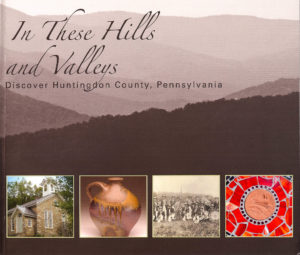
This essay was written in 2009 by Nancy S. Shedd for the Huntingdon County Arts Council publication, In These Hills and Valleys: Discover Huntingdon County, Pennsylvania, and is used with permission.
A rural county like Huntingdon may be torn, when asked to define itself, as to whether the ways in which it is up-to-date and progressive should be emphasized or whether the ways in which it remains unchanged and unchanging should take the spotlight. Most of its residents, and those who vacation here or enjoy retirement here, love it for its unspoiled landscapes and unhurried pace. Thousands of acres of forests and fields instead of the bright lights, and hordes of people, and traffic snarls of big city life.
So does a backwater, in some respects, like Huntingdon County, “the boonies” as it is sometimes characterized, have any claims to fame — any firsts, or tallests, or most populars — that might earn it a place now and then in lists of significant, historical accomplishments? The answer may interest and surprise you.
J.C. Blair, Huntingdon County’s most successful entrepreneur, was responsible for one of the firsts. Blair was honored by the Manufacturing Stationers Trade Association as the inventor of the paper tablet. He developed the concept and the methods for mass producing this common product, which replaced in everyday use what Blair referred to as “the unsanitary slate.” If that adjective puzzles you, think of how school kids cleaned their slates — by spitting on them and rubbing them clean with a rag or their shirttail.
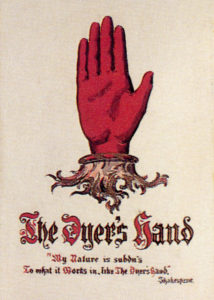
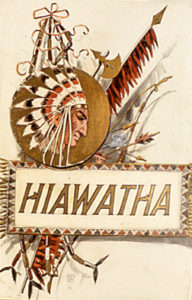
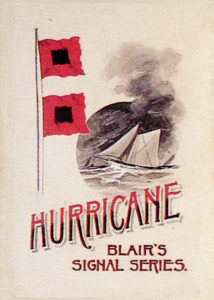 Blair’s genius, which places him first in Huntingdon County entrepreneurial history, was to decorate each tablet with graphically striking images and with clever names, thus creating in potential customers a desire to own the image, whether they needed a tablet or not. It’s a promotional technique still in use that has proven effective over and over again.
Blair’s genius, which places him first in Huntingdon County entrepreneurial history, was to decorate each tablet with graphically striking images and with clever names, thus creating in potential customers a desire to own the image, whether they needed a tablet or not. It’s a promotional technique still in use that has proven effective over and over again.
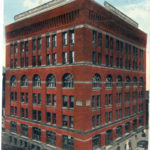 Blair was responsible, as well, for putting Huntingdon on the map architecturally, when in 1889 he constructed a mammoth factory, which was at the time the tallest building between Pittsburg and Philadelphia.
Blair was responsible, as well, for putting Huntingdon on the map architecturally, when in 1889 he constructed a mammoth factory, which was at the time the tallest building between Pittsburg and Philadelphia.
Almost a century before Blair’s entrepreneurial success, George Ashman, Thomas Cromwell, and Edward Ridgeley embarked upon a business venture that was the first in what became a hugely successful industry in Huntingdon County. About 1785, they founded Bedford Furnace in Orbisonia; it was the first iron furnace in the Juniata Valley and the first to make the famous Juniata Iron. (Some sources call Bedford Furnace the first west of the Susquehanna, but there were a half-dozen earlier furnaces in York and Cumberland counties.)
While primitive in construction — thought to be made of logs, rather than stone — Bedford Furnace turned out bar iron and castings of high quality for 35 years. A huge 10-plate stove installed in the county’s first courthouse was cast at Bedford Furnace, and a handsome example of a Bedford Furnace stove survives in the Shaver’s Creek Presbyterian Church at Manor Hill.
Huntingdon County, and the rest of the Juniata Valley, can claim another “first” in the reputation of Juniata Iron itself. It was judged to rank first in quality during the early days of the charcoal iron industry by no less than the well-known inventor and manufacturer, Eli Whitney. He praised Juniata Iron in an 1819 letter to a friend, “From my own observation & experience, I am satisfied that the Juniata Metal, in its native state, is some of the best in the world & that if it is carefully & skillfully manufactured, it will answer an excellent purpose for musket barrels or any other use.” That Juniata Iron was known and in use as far away as New England, and was compared by Whitney to iron produced anywhere in the world, supports its claim to first rank in the industry of the period.
Huntingdon Borough was the birthplace in 1799 of a man who would break new ground in the realm of scientific invention during his life. Joseph Saxton was born on Penn Street, next to the building where J.C. Blair’s much later success story began.
Saxton’s father was a nailmaker; thus young Joseph grew up observing and perhaps experimenting with metal and the machines and techniques used to work it. As a young man, he went to Philadelphia, learned the watchmaking trade, and made a clock for the belfry of Independence Hall. After a period of study in London, he returned to Philadelphia, where he supervised making the machinery for the new U.S. Mint and designed the balances used to verify standard weights.
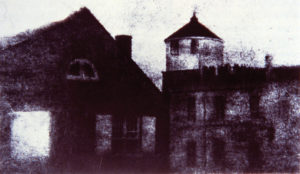 While at the Mint, Saxton learned of Louis Daguerre’s process for making permanent photographic images on silver plates. With the materials at hand, Saxton made a crude camera, aimed it out the window of the Mint at the Central High School, and made what is considered the oldest surviving photograph taken in the United States. (When the French government released Daguerre’s process into the public domain in 1839, numerous would-be photographers experimented immediately and simultaneously. Historians of photography have had difficulty pinning down who took the first American photograph. It is easier to determine which is the old surviving American photograph.)
While at the Mint, Saxton learned of Louis Daguerre’s process for making permanent photographic images on silver plates. With the materials at hand, Saxton made a crude camera, aimed it out the window of the Mint at the Central High School, and made what is considered the oldest surviving photograph taken in the United States. (When the French government released Daguerre’s process into the public domain in 1839, numerous would-be photographers experimented immediately and simultaneously. Historians of photography have had difficulty pinning down who took the first American photograph. It is easier to determine which is the old surviving American photograph.)
Saxton’s lifetime of inventions in the field of scientific instrumentation far outshone his claim to this accomplishment in the field of photography. He spent the last forty years of his life as superintendent of weights and measures for the U.S. Coast Survey in Washington, D.C.
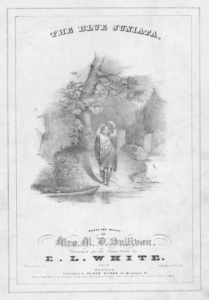 Huntingdon County shares in another “first” of a very different kind — the widespread fame of the Juniata Valley that derived from the popularity of Marion Dix Sullivan’s song “The Blue Juniata.” Published in 1841, after a canal boat trip Mrs. Sullivan took through the Juniata Valley, the song gained wide popularity during the next two decades, making her the first commercially successful woman songwriter.
Huntingdon County shares in another “first” of a very different kind — the widespread fame of the Juniata Valley that derived from the popularity of Marion Dix Sullivan’s song “The Blue Juniata.” Published in 1841, after a canal boat trip Mrs. Sullivan took through the Juniata Valley, the song gained wide popularity during the next two decades, making her the first commercially successful woman songwriter.
A variety of sources document the song being favored by both Union and Confederate soldiers during the Civil War. In a letter to his wife in 1864, Confederate General George Pickett mentioned “The Blue Juniata” as one of the songs played outside his field headquarters, along with “Sweet and Low, “Nellie Gray,” and “Massa’s in the Cold, Cold Ground.”
On the Union side, a correspondent with General William Tecumseh Sherman’s army wrote this poetic account of a quiet evening with the troops:
Sitting before his tent in the glow of a campfire one evening, General Sherman let his cigar go out to listen to an air that a distant band was playing; the musicians ceased at last. The General turned to one of his officers:” Send an orderly to ask that band to play that tune again.” A little while, and the band received the word. The tune was ” The Blue Juniata,” with exquisite variations; the band played it again, even more beautifully than before. Again it ceased and then, off to the right, nearly a quarter mile away, the voices of some soldiers took it up with words. The band, and still another band, played a low accompaniment. Camp after camp began singing the music, and “The Blue Juniata” became, for a few minutes, the oratorio of half an army.
It was a Ken Burns moment, to be sure.
Still another memorable event in the history of “The Blue Juniata” occurred at the end of the Civil War as the war-weary soldiers of Illinois’ 102nd Regiment made their way home. As they traveled through the Juniata Valley, they lifted their voices in song, making the valley ring with their rendition of “The Blue Juniata.”
We no longer sing “The Blue Juniata,” as Ma did in Laura Ingalls Wilder’s “Little House in the Big Woods.” But perhaps we should — to remind us that our beautiful valley’s fame has sometimes spread far afield and received recognition for accomplishments natural, invented, and manufactured. And, of course, Huntingdon County remains first — always and forever — in the hearts of its countians.
